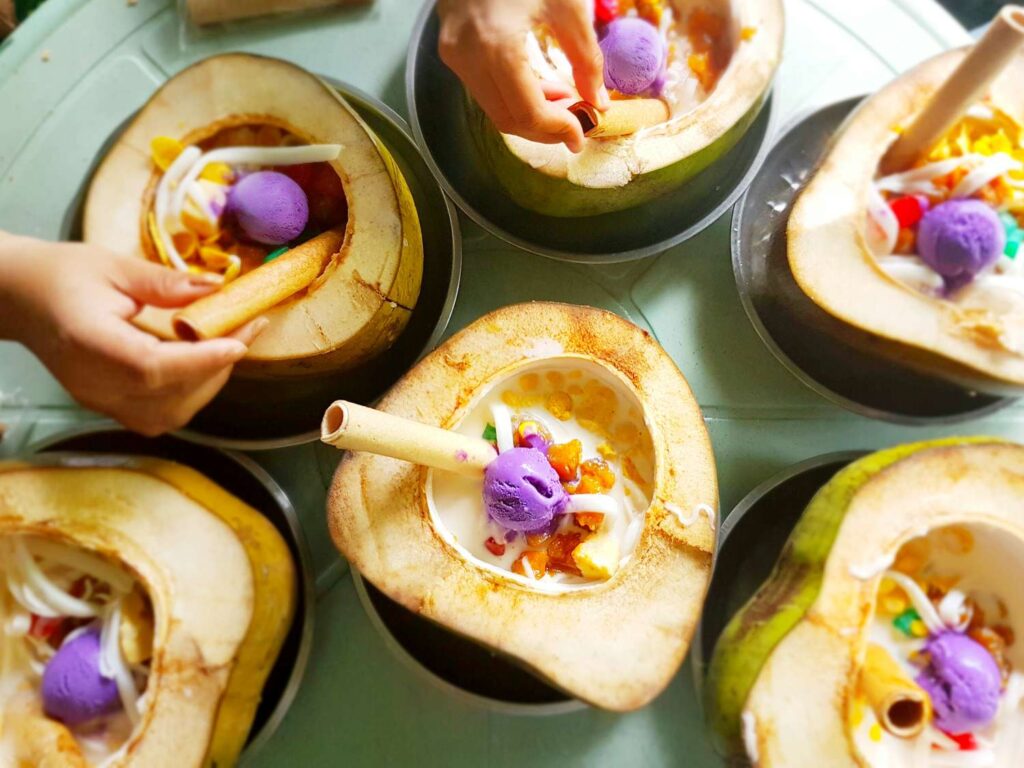filipino desserts recipes are a delightful blend of sweet, savory, and unique flavors that reflect the rich cultural heritage of the Philippines. From creamy leche flan to refreshing halo-halo, these treats are more than just sweets—they are a reflection of Filipino traditions and celebrations. Whether you’re new to Filipino cuisine or a seasoned enthusiast, exploring these desserts is a journey through a vibrant and delicious culinary landscape.
Classic Filipino Desserts
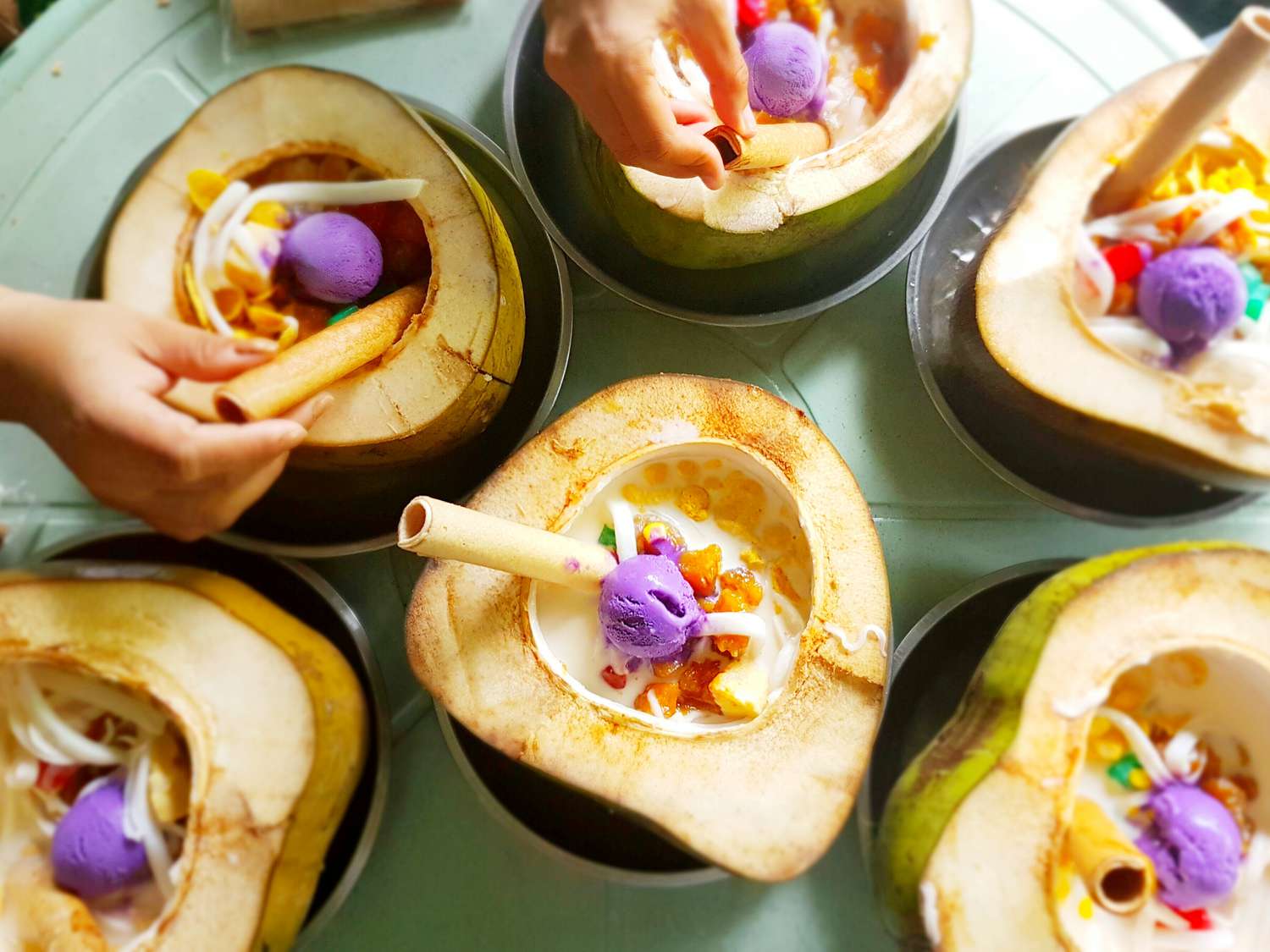
Leche Flan
Leche flan is a classic Filipino dessert that’s beloved for its rich, creamy texture and caramel flavor. Made from eggs, condensed milk, and evaporated milk, this smooth custard is typically topped with a sweet caramel sauce.
Ingredients:
- 10 egg yolks
- 1 can (14 oz) condensed milk
- 1 can (12 oz) evaporated milk
- 1 cup sugar (for caramel sauce)
- 1/4 cup water (for caramel sauce)
Preparation Tips:
- Make the caramel sauce: In a saucepan, combine sugar and water. Heat over medium heat until the sugar dissolves and turns golden brown. Pour the caramel into the bottom of a flan mold.
- Prepare the custard: In a bowl, whisk egg yolks, condensed milk, and evaporated milk. Pour this mixture over the set caramel in the mold.
- Steam the flan: Cover the mold with foil and steam for about 45-60 minutes, or until a toothpick inserted in the center comes out clean. Cool before serving.
Bibingka
Bibingka is a traditional Filipino rice cake often enjoyed during the Christmas season. It’s made with rice flour, coconut milk, and sugar, and traditionally baked in banana leaves.
Ingredients:
- 2 cups rice flour
- 1 cup coconut milk
- 1/2 cup sugar
- 1 tablespoon baking powder
- Banana leaves (for lining)
Traditional Baking Methods:
- Prepare the banana leaves: Soften the leaves by passing them over an open flame. Line a baking pan with the leaves.
- Mix the batter: Combine rice flour, sugar, and baking powder. Stir in coconut milk until smooth.
- Bake: Pour the batter into the prepared pan and bake at 375°F (190°C) for 30-35 minutes, or until a toothpick comes out clean. Top with cheese or salted eggs if desired.
Puto
Puto are steamed rice cakes that are light and fluffy. They come in various flavors and can be topped with cheese or salted eggs.
Ingredients:
- 2 cups rice flour
- 1 cup sugar
- 1 cup coconut milk
- 1 tablespoon baking powder
- 1/2 teaspoon salt
How to Make Different Types of Puto:
- Prepare the batter: Mix rice flour, sugar, baking powder, and salt. Stir in coconut milk until smooth.
- Steam: Pour the batter into small, greased molds and steam for 15-20 minutes. Add cheese or salted eggs on top before steaming if desired.
Halo-Halo
Halo-halo is a popular Filipino dessert known for its mix of various sweet ingredients topped with crushed ice and evaporated milk. It’s perfect for cooling down on a hot day.
Ingredients:
- 1 cup shaved ice
- 1/2 cup sweetened red beans
- 1/2 cup sweetened jackfruit
- 1/2 cup sweetened bananas
- 1/2 cup leche flan (cut into cubes)
- 1/4 cup purple yam (ube) ice cream
- 1/4 cup toasted rice flakes
- Evaporated milk (to taste)
Step-by-Step Guide:
- Layer the ingredients: In a tall glass, layer sweetened red beans, jackfruit, bananas, and leche flan.
- Add ice: Top with shaved ice.
- Add toppings: Add a scoop of ube ice cream and toasted rice flakes.
- Serve: Pour evaporated milk over the top and mix before eating.
Regional Filipino Desserts
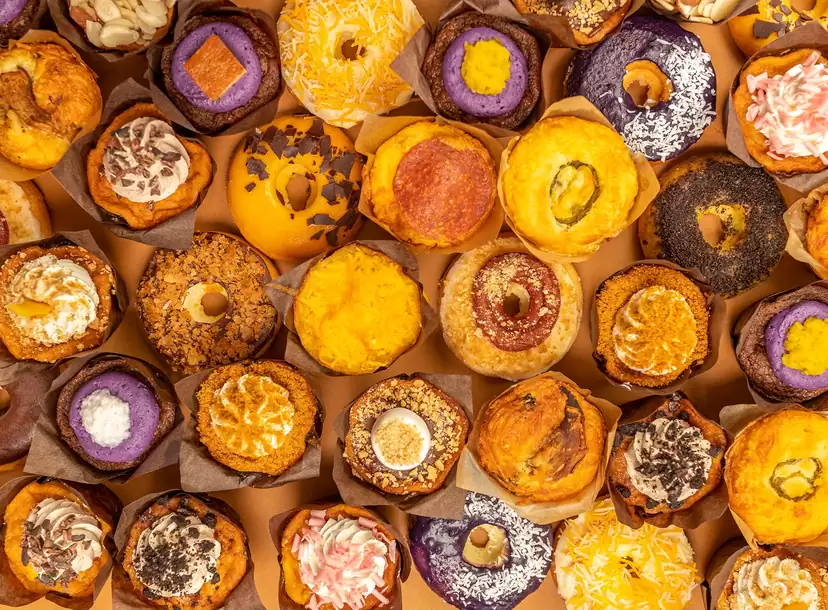
Pastillas de Leche
Pastillas de leche are sweet milk candies that are creamy and melt in your mouth. They’re a favorite treat in the Philippines.
Ingredients:
- 1 can (14 oz) condensed milk
- 1 cup milk powder
- 1/4 cup unsalted butter
- 1/2 teaspoon vanilla extract
Recipe and Preparation Tips:
- Cook the mixture: In a pan, melt the butter, then add condensed milk and cook over low heat, stirring constantly until thickened.
- Add milk powder: Gradually mix in the milk powder and vanilla extract. Continue to cook until the mixture is thick and pulls away from the sides of the pan.
- Cool and shape: Pour the mixture onto a greased surface and cool. Once firm, cut into small pieces and wrap in cellophane.
Kutsinta
Kutsinta is a steamed rice cake that has a distinct caramel flavor and chewy texture. It’s a popular snack or dessert in the Philippines.
Ingredients:
- 1 cup rice flour
- 1 cup brown sugar
- 1 1/2 cups water
- 1 teaspoon lye water (optional)
How to Prepare and Common Variations:
- Mix the batter: Combine rice flour, brown sugar, and water in a bowl. Add lye water if using.
- Pour into molds: Pour the batter into small molds.
- Steam: Steam for 20-25 minutes or until set. Let cool before removing from molds.
Buko Pandan
Buko pandan is a refreshing dessert made with young coconut and pandan-flavored jelly. It’s often served chilled.
Ingredients:
- 1 can (14 oz) young coconut strips
- 1 cup pandan-flavored jelly (cubed)
- 1 cup sweetened condensed milk
- 1 cup all-purpose cream
Step-by-Step Guide:
- Combine ingredients: In a large bowl, mix coconut strips, pandan jelly, condensed milk, and all-purpose cream.
- Chill: Refrigerate for at least 2 hours before serving to let the flavors meld.
Ingredients Commonly Used in Filipino Desserts
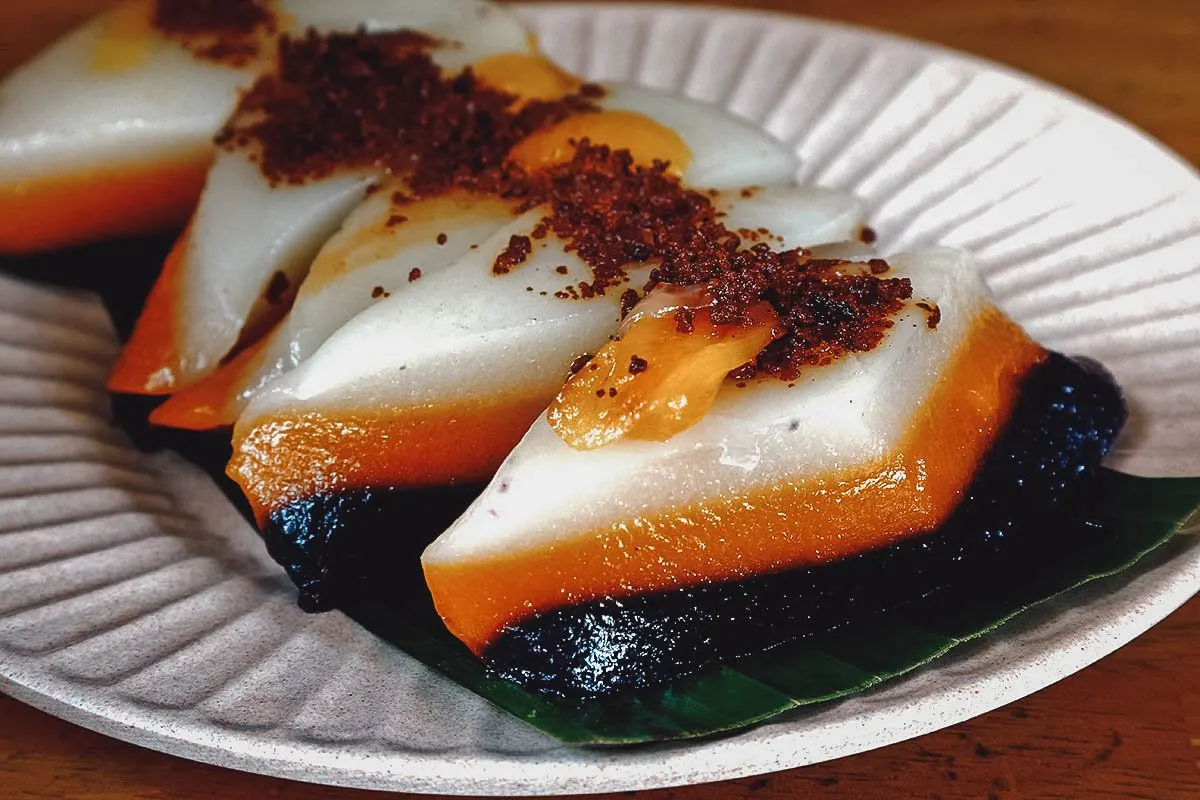
Coconut
Coconut is a staple in Filipino sweets, used in various forms such as fresh, shredded, or milk. It adds a rich, creamy texture and a distinctive flavor to many Filipino desserts recipes.
Ube
Ube, or purple yam, is a popular ingredient known for its vibrant color and unique taste. It’s used in desserts like ube halaya and ube ice cream, making it a key component in several Filipino desserts recipes.
Rice Flour and Glutinous Rice
Rice flour and glutinous rice are essential in many Filipino desserts, providing the chewy texture in treats like bibingka and kutsinta.
Essential Tools for Making Filipino Desserts
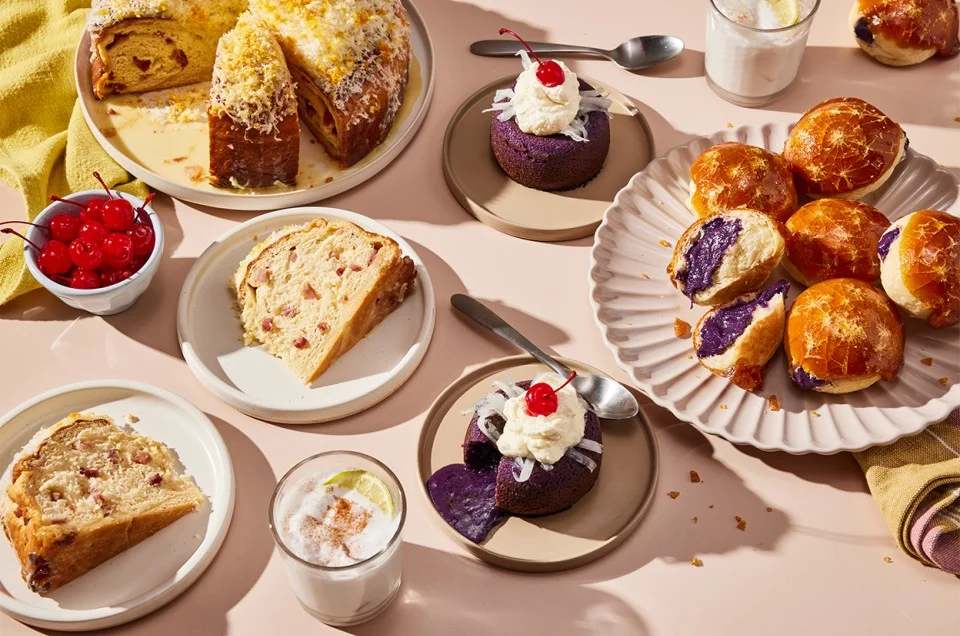
Kitchen Tools and Equipment
To make Filipino desserts, you’ll need some essential kitchen tools:
- Steamer: For cooking steamed desserts like bibingka and kutsinta.
- Mixing bowls: For combining ingredients.
- Whisk: For smooth batters and mixtures.
- Measuring cups and spoons: For accurate measurements.
- Small molds: For shaping individual portions.
- Parchment paper: To prevent sticking in molds.
Detailed Recipes for Selected Desserts
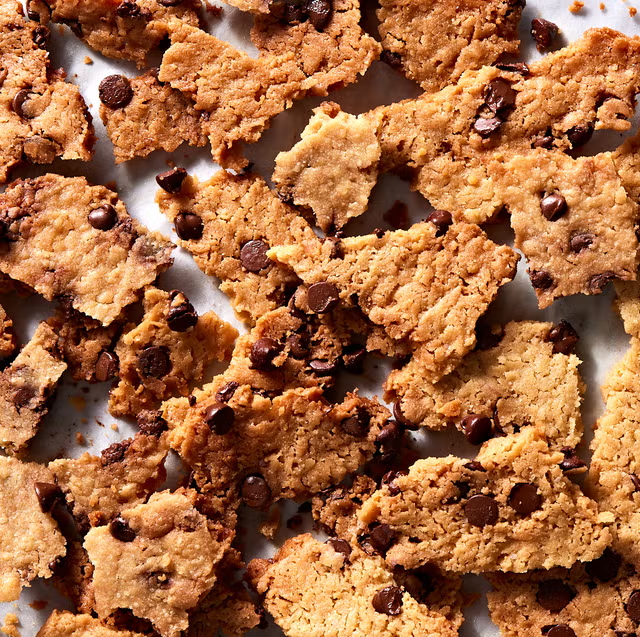
Leche Flan
- Ingredients: 10 egg yolks, 1 can condensed milk, 1 can evaporated milk, 1 cup sugar (for caramel).
- Preparation: Follow the steps for making caramel, preparing the custard, and steaming as detailed above.
Halo-Halo
- Ingredients: 1 cup shaved ice, sweetened beans, jackfruit, bananas, leche flan, ube ice cream, toasted rice flakes, evaporated milk.
- Preparation: Layer and top ingredients as described, then mix before serving.
Bibingka
- Ingredients: 2 cups rice flour, 1 cup coconut milk, 1/2 cup sugar, 1 tablespoon baking powder, banana leaves.
- Preparation: Line the pan with banana leaves, mix the batter, and bake as described above.
Tips and Tricks
Achieving Perfect Texture and Flavor
For the best results with Filipino desserts recipes, ensure your batter is smooth and properly mixed. Adjust sugar levels to taste and use high-quality ingredients for optimal flavor.
Troubleshooting Common Issues
If your desserts are not cooking evenly, check your steaming setup and make sure the water is boiling before adding the molds. Adjust cooking times based on your equipment and recipe specifics.
The Role of Desserts in Filipino Culture
Filipino desserts play a significant role in cultural celebrations and daily life. They often mark special occasions and foster family bonds. Each dessert carries a story and tradition, making them more than just food—they are a celebration of Filipino culture and community.
Conclusion
Exploring Filipino desserts recipes is a delightful journey through a rich culinary heritage. From creamy leche flan to the refreshing halo-halo, these treats offer a taste of the Philippines’ vibrant culture and traditions. Embrace these recipes and bring the unique flavors of Filipino desserts into your home, celebrating the rich history and joyful spirit behind each sweet creation.
FAQs
What are some easy Filipino desserts for beginners?
For beginners, try starting with simpler recipes like puto or bibingka. Both are relatively straightforward and require minimal ingredients.
How can I make Filipino desserts healthier?
Consider reducing sugar, using coconut milk alternatives, or incorporating more fruit into your desserts. For example, you can use less sweetened condensed milk or opt for fresh fruit toppings.
Where can I find ingredients for Filipino sweets outside the Philippines?
Many Filipino ingredients can be found in Asian grocery stores or online. Look for specialty items like rice flour, coconut milk, and ube powder.
Can I make Filipino desserts ahead of time?
Yes, many Filipino desserts, such as leche flan and kutsinta, can be made ahead of time. Store them in airtight containers to maintain freshness.
Are there any vegan options for traditional Filipino desserts?
Yes, you can adapt traditional recipes to be vegan by substituting dairy ingredients with plant-based alternatives and using egg replacers.

